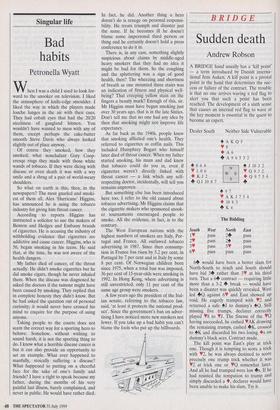BRIDGE
Sudden death
Andrew Robson
A BRIDGE hand usually has a 'kill point' — a term introduced by Danish interna- tional Jens Auken. A kill point is a pivotal point in the hand that determines the suc- cess or failure of the contract. The trouble is that no one arrives waving a red flag to alert you that such a point has been reached. The development of a sixth sense that causes an internal red flag to wave at the key moment is essential in the quest to become an expert.
Dealer South Neither Side Vulnerable 4 A K Q 5 IP 8 • A 6 6 A 9 6 5 3 2 4 8 6 4 No 1 0 6
♦ K J 2 Q J 10 8 7
4 J 10 3 ♦ Q 9 3 ♦ Q 9 7 2 2 5 4
N W S E
4 9 7 IP A K J 7 5 4
♦ 10 8 3 + K4 The Bidding South West North East 11, pass pass 2V pass 24 pass 3r pass 5V pass 6, pass pass pass 6+ would have been a better slam for North-South to reach and South should have bid 3+ rather than 3, at his third turn. That a 64 contract — requiring little more than a 3-2 4 break — would have been a disaster was quickly revealed. West led +0 against 6V and East showed up void. He eagerly trumped with V2 and returned a safe 4J to dummy's 40. Still missing five trumps, declarer correctly played 118 to 1►J. The finesse of the VO having succeeded, he cashed VAK drawing the remaining trumps, cashed 4K, crossed to 4K and discarded his two losing 4s on dummy's black aces. Contract made.
The kill point was East's play at trick one. Though it is tempting to score a trick with V2, he was always destined to score precisely one trump trick whether it was 112 at trick one or VQ somewhat later. And all he had trumped were low 4s. If he had resisted the tempation to trump and simply discarded a ♦, declarer would have been unable to make his slam. Try it.


























































 Previous page
Previous page